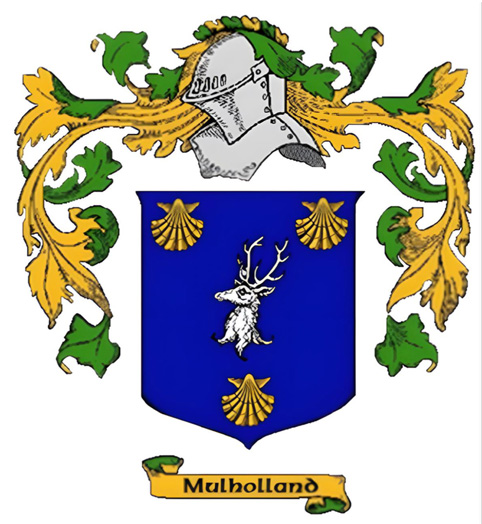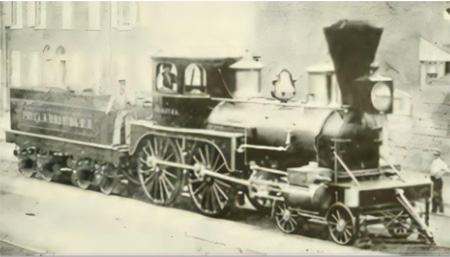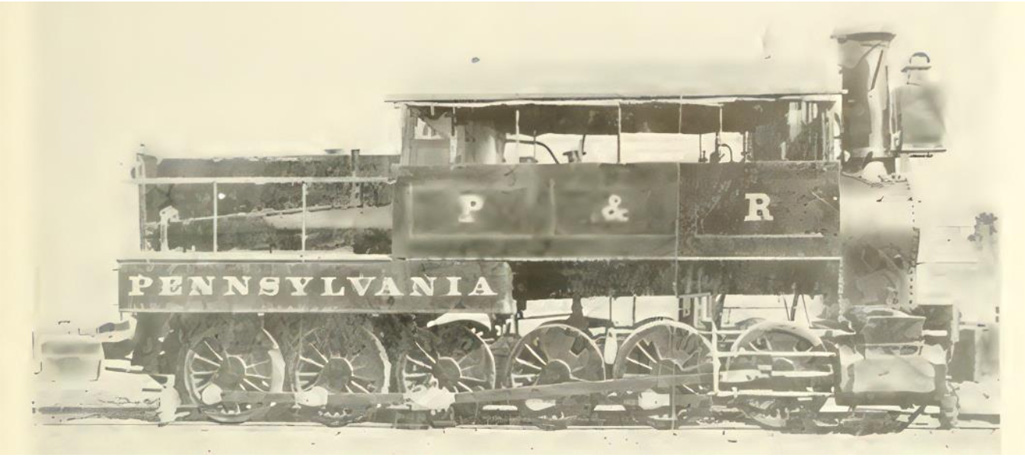 |
The Millholland FamilyChapter 5The Family ofJames MillhollandAssociated Surnames in this chapter: Curtis, Hoff
|

|
James Millholland
Third Generation
| Line of succession | ||||
| Gen 1 James Millholland Isabella Douglass |
⇨ | Gen 2 Robert Douglass Millholland Nancy Ann Day |
⇨ | Gen 3 James Millholland |

James was born in Baltimore MD on October 06, 1812 and died August 18, 1875 in Reading, PA. He married first Fanny Curtis on November 30, 1837 in Stratford, CT. Fanny was born in April 24, 1818 and died Feburary 16, 1864. He marriedb second Mary Ann Hoff on April 16, 1866. Mary Ann was born April 11, 1832 and died June 07, 1899. James, Fanny and Mary Ann are all buried in Charles Evans Cemetery, Reading, PA.
Son of Robert Douglass Millholland and Nancy Ann Day, He started out in the sailing ship outfitting business in his father’s shipyard, but soon gave this up to learn the trade of machinist.

was built by Millholland in 1859. It was the first of a very
successful class of passenger locomotives and was not
retired until 1883. (Smithsonian photo 40630.)
It was while working in the shops of George W. Johnson in Baltimore that he helped construct the Tom Thumb locomotive for Peter Cooper of New York. This locomotive, with one cylinder, and weighing hardly more than a ton was the first locomotive built in America. On its trial trip it pulled a boat-shaped car with a load of passengers, among whom were the directors on the Baltimore and Ohio Railroad August 28, 1830. Before the use of steam, horses furnished the motive power on the railroads.
We find that in 1835 he was associated with James Allaire of the Allaire Iron Works in New York, constructors of marine engines who at the time had the finest machine shops in the United States. It was while he was living in New York that he became acquainted with and married Fanny Curtis in Stratford, CT on November 30, 1837. She was born in Stratford on April 24, 1818, and died in Reading, PA on February 16, 1864, just nine days after her son Paul Douglass Millholland was born. She is buried in Charles Evans Cemetery in Reading.
In 1838 James became Master of Machinery for the Baltimore and Susquehanna Railroad, now the Northern Central Railroad, which had been completed from Baltimore to York, PA.
Later, about 1840, he returned to Baltimore where he held the position of Master Mechanic for the Baltimore and Ohio Railroad. He went to Reading, PA and entered the employ of the Philadelphia and Reading Railroad on September 01, 1848, as Superintendent of Motive Power and Rolling Equipment. During his association with the company from 1848 through 1866 he designed and built all of the locomotives.
In 1866 he resigned from the Reading Road to accept the presidency of the Consolidated Coal Company and the Cumberland and Pennsylvania Railroad Company at Mt. Savage, MD. In the spring of 1869, he resigned this position and returned to Reading and in 1870 went into the banking business with John Hoff, the father of his second wife, Mary Ann Hoff. She was born on April 04, 1832, and married James on 04-16-1866 in Reading. James and Mary Ann had two sons. Mary Ann died June 07, 1899, in Pennsylvania.

in the world when constructed by Millholland in 1863;
this 50-ton locomotive was in service until 1885.
One pair of driving wheels was removed in 1870.
During the great panic of 1874-75, the Jay Cooke and Henry Clews banking house failures in New York nearly ruined the Hoff and Millholland firm financially. John Hoff died in March 1874 and James Millholland on August 18, 1875. James is buried in Charles Evans Cemetery in Reading, PA. The bank however paid every dollar of its indebtedness and every depositor received dollar for dollar with interest to date of settlement.
It was James’ patented boiler with water grate bars invention that was incorporated in a locomotive named the Illinois, built by Philadelphia and Reading shops in May 1852. It weighed 27.7 tons and had forged iron driving wheels seven feet in diameter. A large drawing of this locomotive is in the Smithsonian Institute, Washington, DC, with the following inscription, “Built under the Patent of James Millholland for the Philadelphia and Reading Railroad.” The Illinois was very successful and from that year on, all reading locomotives were built to use this fuel.
He was the first to shrink tires on locomotive driving wheels, which is still in practice to this day (1955.), the first to install blowers in locomotives, applied the first cow catchers, first to introduce counterbalance in wheels, first to place a bell on a locomotive, and first to standardize designs so that parts would be interchangeable in locomotives of different classes. His locomotives were world beaters for power, speed, and pulling capacity.
One of his greatest inventions and patents was the steam injector for injecting water into locomotive boilers when under steam pressure. Previous to this, the water was injected by feed-water piston pumps which were operated from the running gear. The patent was sold to a New York company for $100,000.00 (1.8M in today’s dollar.)
- Children of James Millholland and Fanny Curtis
- Harriet Ann Millholland
- James Allaire Millholland
- Fanny Curtis Millholland
- William Ward Millholland
- Henry Millholland
- Paul Douglass Millholland
- Children of James Millholland and Mary Ann Hoff
- John Hoff Millholland
- Robert Douglass Millholland
Obituary of James Millholland, Reading Times 08-19-1875
James Millholland, Esq., a prominent and well-known citizen of Reading, died at his residence, No. 132 North Fifth Street, at seven o’clock yesterday morning, after a lingering illness, in the 63rd year of his age. About two and a half years ago Mr. Millholland was attacked with pneumonia, which eventuated in the chronic pulmonary complaint the finally proved fatal. He spent last winter with his family at Aikens, SC. Returning home about the middle of June without any permanent improvement in his health. Though it was evident at different periods throughout his illness that recovery was impossible, it was not until within a week past that his immediate decease was apprehended. So long and so tenaciously had his iron constitution resisted the approach of the destroyer, that not even his medical attendants could predict with any degree of assurance how long he might last, until fatal complications of his disease recently began to make their appearance. Though he had toward the last suffered considerable pain, his end was rational and peaceful
Mr. Millholland was born in the city of Baltimore October 6, 1812. He was the oldest son of Robert D. Millholland, who was engaged in the business of manufacturing fittings for ships. He received a private school education and evinced an early proficiency in mathematical and geographical studies. Exhibiting also a special genius mechanics, he was at the age of eighteen apprenticed as a machinist and assisted in the construction of the first railway locomotive built in the United States, which was the invention of Peter Cooper, of New York, and was manufactured for the Baltimore and Ohio Railroad. He was also employed in the building of several other of the earlier patterns of engines, becoming thus identified with the construction of the locomotive from its earliest history in this country. At the day the facilities for the different branches of mechanics were very imperfect, necessitating severe manual labor, and one result of his own rigorous experience was the considerate care which he ever exercised in the amount of physical exertion which he exacted from those under his superintendence.
In 1832 he went to the city of New York and was employed in the Allaise (Allaire) Iron Works, the principal business of which was the manufacture of marine engines, here was constructed the machinery for the first American steamers which sailed from that port, those of the New York and Charleston line. In 1836 he was employed to erect the machinery of a large steam sawmill constructed at the above works for Robinson, Martino & Co., of Mobile, Alabama, who employed him to superintend its operation, at the then unusually large salary of ten thousand dollars a year. This establishment having succumbed to the financial crisis of the following year, he returned to New York, and in 1838 became Master of Machinery of the Baltimore and Susquehanna, now Northern Central Railroad, which was completed in that year from Baltimore to York, PA. He did much to improve the mechanical and engineering facilities of this road, and while in its employ designed and applied his first inventions, a wooden spring for cars, and a drum brake, afterwards modified into a lever brake, the earliest contrivance for applying the brakes simultaneously to all the wheels of an eight wheeled car. A cast iron crank axle for locomotives, which, with the combinations he employed, successfully took the place of the wrought iron axle then generally supposed to be the best adapted for this purpose, was another of his productions.
In 1848 he was employed by the Philadelphia and Reading Railroad Company in the capacity of Master of Machinery, to succeed Lewis Kirk, and removed to Reading. During the 18 years in which he occupied this position he did much to advance the mechanical equipment of this road to its present high standard of perfection. He applied to its locomotives a very important improvement known as the wrought iron hollow grate bar, through which water is made to circulate, preventing the destruction of the material by the action of the fire; and also made a series of successful experiments in the adaption of anthracite coal as a fuel for locomotive engines. The science of mechanics was his life-long study, and the locomotive the special object to which he devoted the energies of his constructive genius. In this line of invention, he achieved quite a wide reputation. In his capacity of Master Machinist of the Reading Road, he took a great interest in the advancement and welfare of the young mechanics in its employ, many of whom were indebted to him for valuable instruction, encouragement, and assistance.
In 1866 he resigned his connection with the Reading Road to accept the Presidency of the Consolidated Coal Company, and Cumberland and Pennsylvania Railroad Company, whose extensive works were located at Mt. Savage, MD. Of this railroad Company his eldest son, Mr. James A. Millholland, is at present time Vice President. In the spring of 1869 Mr. Millholland gave up his position and returned to Reading. In April 1870, he went into the banking business with his father- in-law, Mr. John Hoff, recently deceased, under the firm of Hoff and Millholland.
Having always been identified with the Republican party, he was in 1872 its candidate for Congress in this, the Berks district, against Hiester Clymer, the present member, receiving 7,783 votes to 13,854 cast for his opponent.
He was also one of the partners in the Leesport Iron Works and was prominently identified with the business interests of the city and county. He was at the time of his death a member of the Board of Directors of the Reading Fire Insurance Company and the Charles Evans Cemetery Company. For over twenty years he was a member the First Presbyterian church, where his funeral is announced to take place on Saturday afternoon next, at 2 o’clock. He was a prominent member of the Masonic and Odd Fellows Orders, being Past Commander of DeMolay Commandery No. 9, Past Master of Chandler Lodge No. 227, and Past High Priest of Reading Chapter No. 152.
Personally, Mr. Millholland was distinguished for his great energy and decision of character, the indomitable resolution and perseverance with which he adhered to his plans and purposes, and an unswerving integrity, which prompted him in official life, to act with the strictest fidelity to his employers, and in his private relations, to be just toward all men. Added to these was a frankness and generosity of disposition which made him many friends. In his decease Reading loses an esteemed and valuable citizen.
Obituary of Mary Ann Hoff, Reading Eagle 06-07-1899
Mrs. Mary A. Millholland, widow of James Millholland, died of a complication of diseases at 7:45 a.m. to-day at her residence, 132 North 5th, aged 68 years. She was ill since January last. Deceased was born in Reading and was the daughter of Mr. and Mrs. John Hoff, both long deceased. Her husband, who was the well-known master mechanic of the P. & R. Railway, died in 1875. Mrs. Millholland was a member of the First Presbyterian church and had a large circle of friends. She leaves one son, Robert D. Millholland, two brothers, H.A. Hoff, Reading, and George B. Hoff, together with these sisters: Mrs. Henry Johnston and Mrs. Louis Richards, Reading; Mrs. George F. Krischer and Mrs. William H. Johnston, New York. Deceased was a loving mother, charitable to an unusual degree, devoted to her family and noted for her kindness of heart.